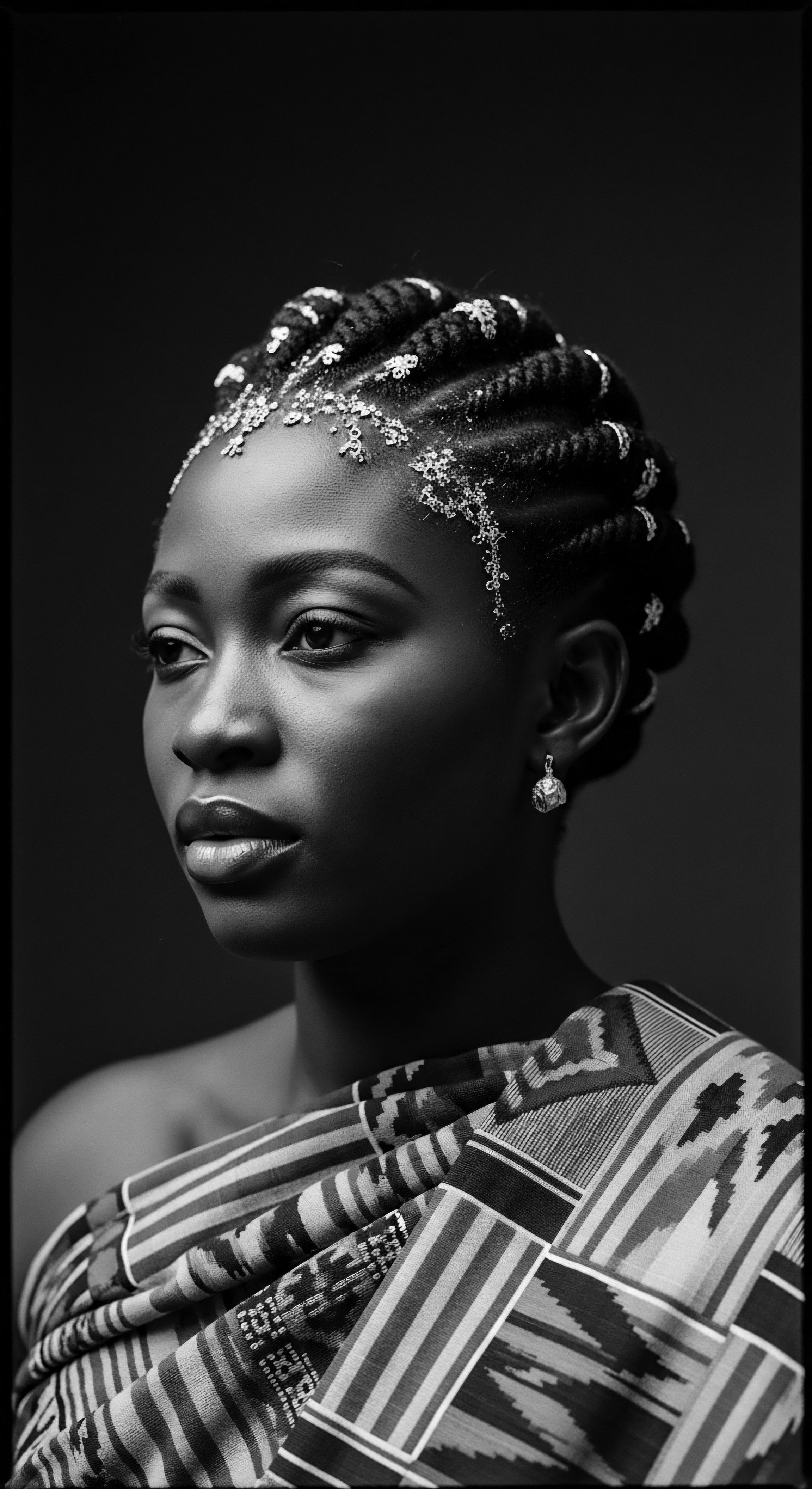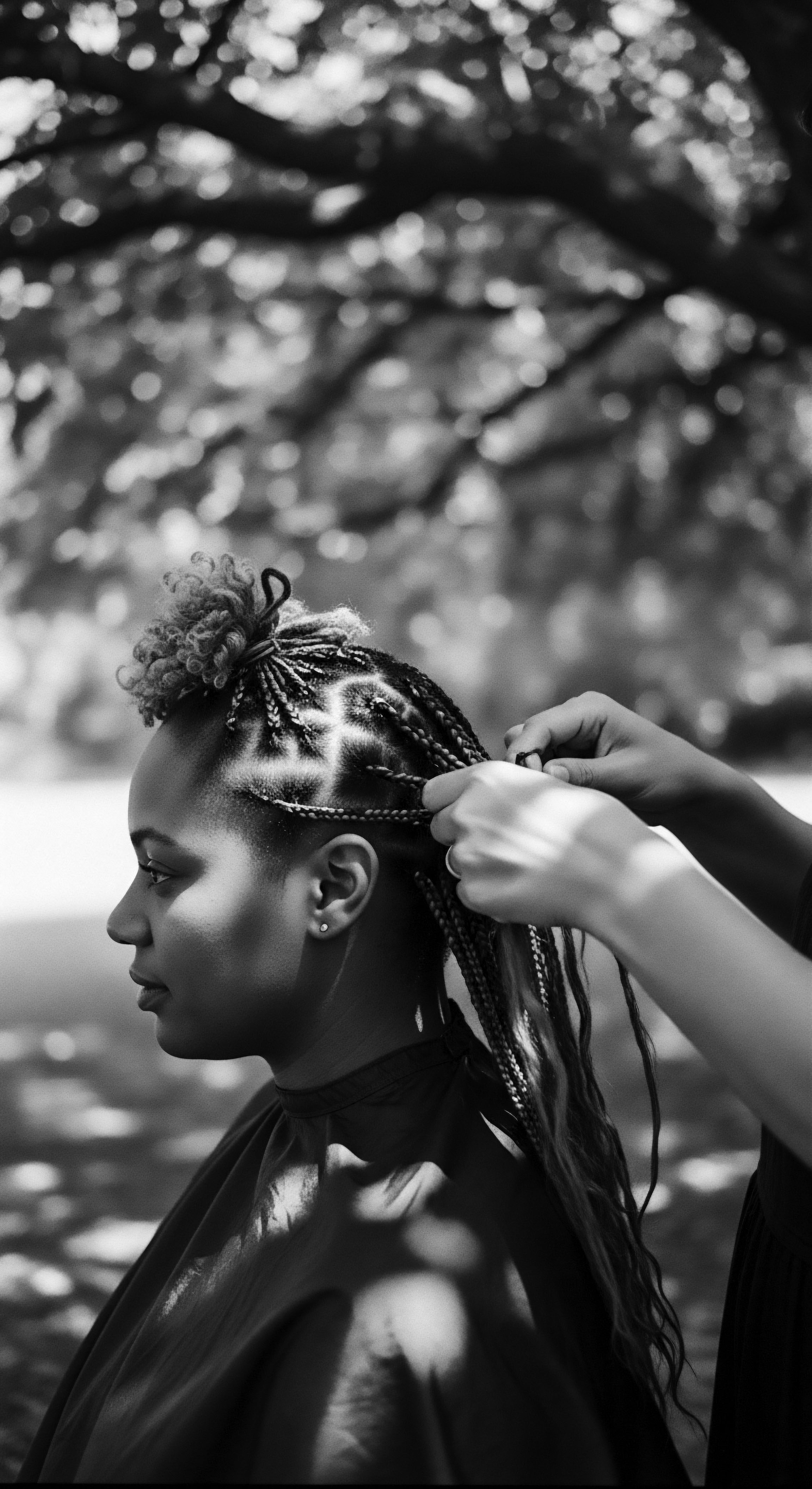
Fundamentals
The story of plant dyes in hair stretches back to the earliest moments of human ingenuity, long before synthetic chemistry reshaped our world. Its initial meaning resides in elemental biology and the intuitive understanding of nature’s bounty. Plant dyes, at their simplest, are coloring agents derived directly from flora—from the vibrant leaves of a henna plant, the roots of a madder, or the woody heart of logwood. These botanical elements contain natural pigments, organic compounds that possess the ability to impart hues upon fibers, including the strands that crown our heads.
For textured hair, the history of plant dyes carries a particular weight, a deep resonance that extends beyond mere aesthetics. This heritage is woven into the fabric of ancestral practices, revealing ancient knowledge about the earth’s offerings and their beneficial properties. Plant dyes were not simply about altering outward appearance; they held significances related to health, identity, community, and even spiritual connections. The use of these earth-derived colorants speaks to a time when care for the self was intrinsically linked to a respect for the natural world, a reciprocity that nourished both spirit and strand.

Echoes from the Source ❉ Botanical Beginnings
In many ancient societies, knowledge of plant dyes was a closely guarded tradition, passed down through generations. People observed which plants yielded lasting colors, which offered conditioning properties, and which possessed qualities suitable for adornment. The exploration of these natural colorants began with empirical observation, with communities learning through trial and repeated interaction with their local environments. Each region offered a different palette, a unique array of botanical wonders that contributed to distinct hair traditions.
Consider the very act of preparing these dyes ❉ collecting leaves, grinding roots, simmering bark. This was a patient, deliberate process, often communal, connecting individuals to the land and to one another. The resulting pastes or rinses would be applied with intention, not just for color, but for the inherent goodness they imparted.
The natural compounds found in these plants often offered more than pigment; they contained conditioning agents, antimicrobial properties, or even UV protection. For hair that often faced the rigors of sun and climate, these properties were invaluable, contributing to strength and vitality.
The initial purpose of plant dyes transcended mere adornment, providing a profound connection to the earth’s nurturing capabilities for hair.

Early Applications in Textured Hair Care
Across Africa, and within diaspora communities, plant dyes became integral to hair care and cultural expression. Early civilizations understood the rich potential residing within plants to alter hair’s appearance, often to convey social standing, marital status, or even spiritual devotion. These applications were not haphazard; they were informed by centuries of accumulated wisdom, deeply ingrained in daily rituals. The pigments from plants provided an opportunity to signify identity, to beautify, and to protect the hair from environmental stressors.
The practice of using plant dyes represented a deliberate choice to work in harmony with the environment, deriving beauty solutions from what the earth readily provided. These choices contrast sharply with the later reliance on harsh, synthetic alternatives. The history of plant dyes serves as a reminder of an era when hair care was a thoughtful process, deeply respected for its connection to heritage and its ability to maintain hair’s inherent health. This foundational understanding sets the stage for appreciating the enduring legacy of botanical colorants.
The elemental components of plant dyes involve complex organic molecules. These molecules, often flavonoids, quinones, or carotenoids, interact with the keratin structure of the hair shaft. Unlike many modern synthetic dyes that penetrate and alter the hair’s internal structure through chemical reactions, many traditional plant dyes function as direct dyes.
They coat the outer layers of the hair, depositing pigment and often adding a protective sheen. This difference in mechanism is significant, contributing to the often gentler nature of botanical applications on delicate hair strands.
- Henna (Lawsonia inermis) ❉ This plant, particularly its leaves, has been dried and powdered for millennia to produce a reddish-orange dye. It has been instrumental in hair coloring traditions across North Africa, the Middle East, and parts of Asia, lending warm hues while conditioning strands.
- Indigo (Indigofera tinctoria) ❉ Prized for its deep blue pigment, indigo, derived from the plant’s leaves, was frequently combined with henna to achieve shades ranging from deep brown to rich black, providing depth and sheen to hair.
- Red Ochre ❉ While a mineral earth pigment rather than a plant, its historical application with natural fats and plant-based binders makes it relevant. Indigenous communities, such as the Himba, used this mixture to adorn and protect hair, imparting a reddish hue and offering natural sun protection.

Intermediate
The journey of plant dyes into the realm of hair color is a profound cultural story, far richer than a simple timeline of botanical discoveries. Its meaning extends into the very spirit of communities, shaping notions of beauty, status, and collective identity across continents and generations. This intermediate exploration unveils how traditional wisdom, passed through discerning hands, transformed raw plant material into treasured hair treatments, particularly within Black and mixed-race hair experiences.
Across various African societies, the application of plant dyes was a ritualistic act, often imbued with significant cultural weight. It was a practice rooted in deep knowledge of local flora and the specific ways these plants could nourish, protect, and adorn hair textures that demanded specialized care. These formulations were not standardized; instead, they were deeply personal and communal, reflecting the specific botanical heritage of each region.
The preparation involved careful processing of leaves, roots, or bark, often through grinding, infusing, or simmering, to extract the potent coloring compounds. The resulting mixtures, whether thick pastes or fragrant rinses, provided hues that communicated belonging, celebration, or life passage.

The Tender Thread ❉ Living Traditions of Care and Community
The continuity of plant dye use for hair speaks to an enduring wisdom, a collective memory held within communities. This wisdom recognized that hair, particularly textured hair, was more than just fiber; it was a living canvas, a repository of identity and history. Applying these dyes was often a communal activity, fostering bonds and sharing knowledge.
Mothers taught daughters, elders guided the young, ensuring the preservation of these time-honored practices. This communal aspect underscores how deeply integrated plant dyes were into daily life and social structures, far beyond a fleeting trend.
For many generations of Black and mixed-race people, these traditions served as powerful affirmations of self and lineage. In contexts where identity was challenged or erased, the continuity of ancestral hair care rituals, including the use of plant dyes, stood as a quiet yet potent act of preservation. These practices allowed individuals to retain a visible connection to their origins, a testament to resilience. The colors imparted by henna or indigo became markers of heritage, signifying a continuity of custom and a proud declaration of cultural roots.
Ancestral hair rituals involving plant dyes served as profound statements of identity and a testament to cultural endurance.

Cultural Significations of Hair Color
The colors themselves held layers of meaning. A deep, rich black might signify maturity or wisdom, while earthy reds and browns could be associated with vitality or connection to the land. These associations varied greatly by community and era.
For instance, in ancient Egypt, henna was utilized not merely for its reddish hue but also to signify purity and status, gracing the hair and nails of pharaohs. The practice underscored a broader cultural understanding of hair as a profound element of personal and communal expression.
A compelling historical instance that powerfully illustrates the Plant Dyes History’s connection to textured hair heritage and ancestral practices is the traditional use of red ochre by the Himba people of Namibia. This indigenous community, residing in the harsh climate of the Kunene Region, developed a unique practice of blending finely ground red ochre (a naturally occurring iron oxide pigment) with butterfat and sometimes aromatic resins to create a paste known as Otjize. This vibrant mixture is applied daily to both skin and hair, particularly the women’s distinctive braided and elaborately styled tresses (Rifkin, 2015b).
The significance of otjize extends beyond mere aesthetics. Its regular application serves multiple practical purposes ❉ it acts as a cleansing agent, a moisturizer, and a protective barrier against the intense sun and arid conditions of the Namib desert. Furthermore, the reddish hue imparted to the hair and skin holds deep cultural and symbolic meaning for the Himba.
It signifies their connection to the earth, their cattle (a source of their wealth and sustenance), and their ideal of beauty, linking them intrinsically to their lineage and environment. This practice has been passed down through generations, representing an unbroken chain of ancestral knowledge and a powerful assertion of identity through hair adornment and care.
| Plant Dye Henna (Lawsonia inermis) |
| Key Historical Application (Hair) Coloring hair reddish-orange, conditioning, scalp health, covering gray. Often used in Ancient Egypt, North Africa, Middle East. |
| Cultural Significance/Benefits Symbol of purity, status, celebration; strengthening hair strands; spiritual protection. |
| Plant Dye Indigo (Indigofera tinctoria) |
| Key Historical Application (Hair) Achieving deep blue-black or brown shades when mixed with henna; adding sheen and volume. Widespread in Africa, India, Arab world. |
| Cultural Significance/Benefits Cosmetic enhancement; symbolic of prosperity (historically called "blue gold"); often used for its clarifying properties. |
| Plant Dye Ochre (Red Pigment) |
| Key Historical Application (Hair) Mixed with fats for hair coating, sun protection, cleansing, and adornment. Notably by Himba women in Namibia. |
| Cultural Significance/Benefits Symbol of connection to earth, wealth (cattle), beauty ideal; practical protection against harsh environment. |
| Plant Dye Turmeric (Curcuma longa) |
| Key Historical Application (Hair) Imparting yellow to golden tones; used in ancient Egyptian hair recipes. |
| Cultural Significance/Benefits Part of broader cosmetic and medicinal practices; often combined with other botanicals. |
| Plant Dye These traditional botanical applications illustrate a profound historical understanding of hair's natural qualities and the deeply personal connection to cultural identity. |

From Elemental to Intentional ❉ A Shift in Understanding
The intermediate meaning of plant dyes goes beyond their elemental composition, delving into the intentionality behind their use. It acknowledges that ancestors were not just applying color; they were engaging in sophisticated forms of cosmetic science, albeit rooted in empirical observation rather than laboratory analysis. The precise ratios, the timing of application, the specific rituals surrounding these processes—all speak to a complex body of knowledge that was both practical and deeply spiritual.
This historical insight allows us to appreciate the subtle chemistry at play. The lawsone molecule in henna, for example, binds to the keratin in hair, creating a lasting stain. Indigo’s indigotin interacts in a different way, often layered over henna to achieve darker shades.
These interactions were not understood in molecular terms in antiquity, yet the practical effects were known and expertly manipulated. This blend of scientific outcome and ancestral practice is a cornerstone of Roothea’s perspective, bridging historical wisdom with contemporary understanding.

Academic
The academic meaning of Plant Dyes History transcends anecdotal accounts, rooting itself in rigorous ethnobotanical, anthropological, and chemical analyses. It presents a sophisticated interpretation of how botanical colorants have shaped human societies, particularly examining their enduring meaning within the heritage of textured hair across global Black and mixed-race communities. This exploration requires a granular examination of traditional knowledge systems, a scientific understanding of phytochemical interactions, and a critical lens on the socio-political dynamics that influenced hair practices throughout history.
At its academic core, Plant Dyes History is the comprehensive study of the systematic utilization of organic compounds derived from flora for the purpose of altering the appearance of hair, body, and textiles across human civilizations. This delineation extends to encompass the ethnobotanical origins of dye-yielding plants, the traditional methods of pigment extraction and application , and the sociocultural meaning embedded in these practices. Its scholarly examination recognizes that these historical applications were often highly sophisticated, reflecting an intricate understanding of natural chemistry and environmental resources long before the advent of modern scientific frameworks. The meaning of this history is therefore complex, intertwining material culture with abstract concepts of identity, status, and resistance.

Phytochemistry and Hair Substrate Interaction
From a scientific standpoint, the efficacy of plant dyes rests upon the specific phytochemicals they contain. For instance, the naphthoquinone lawsone from Lawsonia inermis (henna) and the indigotin from Indigofera tinctoria (indigo) represent two prominent examples. Lawsone reacts with the keratinized proteins of the hair shaft, forming a semi-permanent to permanent bond that deposits its characteristic reddish-orange pigment. This interaction occurs primarily with the free amino groups present in the hair’s keratin, allowing the dye molecule to adsorb onto and partially penetrate the cuticle layers, and sometimes the cortex itself.
Indigo, conversely, is typically applied in a reduced, colorless form which then oxidizes upon exposure to air, depositing its blue pigment. When layered over henna, or used in conjunction, the interplay of these two botanical agents can yield a spectrum of deep browns to intense black shades, demonstrating a sophisticated ancestral comprehension of color theory and chemical layering. This deliberate approach to combining different plant materials highlights a nuanced understanding of their reactive properties, allowing for a broader range of desired outcomes on various hair types, including the diverse textures within Black and mixed-race hair. The distinct structure of textured hair, with its unique cuticle patterns and coil formations, influences how these plant pigments adhere and reflect light, creating a depth of color that is unique to these applications.
The academic lens reveals plant dyes as ancient bioremediation tools, showcasing sophisticated ancestral knowledge of natural chemistry and hair biology.

Archaeological and Anthropological Narratives
Archaeological findings consistently push back the timeline of plant dye use, revealing a deep antiquity. Evidence of ochre, often mixed with organic binders like fats, dates back hundreds of millennia, indicating its broad use for body and hair adornment as well as ritualistic purposes across various human populations. The presence of ancient hair dyeing recipes, such as those found in the Egyptian Ebers Papyrus from circa 1550 BCE, details the use of plant extracts to darken gray hair. These textual and material records allow scholars to reconstruct the technical processes and the cultural frameworks surrounding hair coloration.
Anthropological studies offer a deeper understanding of the cultural lexicon surrounding hair and its adornment. Within numerous African societies, hair carried immense semiotic weight, communicating social status, marital availability, group affiliation, and spiritual connection. The deliberate modification of hair color through plant dyes was thus a powerful form of non-verbal communication. For example, among the Himba people of Namibia, the daily application of Otjize, a paste of red ochre and butterfat, to their hair and skin is more than a cosmetic choice.
It functions as a protective measure against the harsh desert environment, a traditional aesthetic standard, and a visible declaration of their identity, lineage, and connection to their pastoral lifestyle (Rifkin, 2015b). This enduring tradition represents a profound embodiment of ancestral knowledge where hair care is inseparable from cultural survival and self-expression. The distinct spiral patterns of Himba hair, carefully coated with otjize, demonstrate how specific hair textures served as canvases for these deep cultural practices, becoming living archives of heritage.
Another significant instance of historical plant dye application for hair can be found in the traditions of ancient Mali. Here, henna , known locally as Diabi, was traditionally worn by older women as a symbol of wisdom, strength, and cultural pride. This practice eventually extended to younger women, particularly for important life ceremonies such as weddings and naming rituals. The evolving usage of diabi within Malian society reflects how the meaning and application of plant dyes adapt while retaining their profound connection to community identity and inherited customs.
- Ethnobotanical Survey ❉ Documenting the specific plant species traditionally used for hair dyes in particular regions, noting indigenous names, growth habitats, and methods of harvest and preparation.
- Chemical Analysis ❉ Identifying the active colorant compounds within plant extracts (e.g. lawsone, indigotin, curcuminoids) and analyzing their molecular interactions with hair keratin.
- Archaeological Interpretation ❉ Examining physical evidence, such as preserved hair strands from ancient burial sites or ancient dye preparation tools, to infer historical practices.
- Oral Histories & Cultural Studies ❉ Collecting narratives and observing contemporary traditional practices to understand the symbolic meanings and social roles of hair dyeing in living communities.

Interconnected Incidences and Long-Term Consequences
The study of Plant Dyes History also critically examines the long-term consequences of these practices, both beneficial and challenging. While generally less irritating than many synthetic counterparts, certain natural dyes, when improperly prepared or adulterated, could lead to sensitivities. Moreover, the shift from localized plant dye practices to a globalized beauty industry introduced new complexities, sometimes divorcing the ingredient from its ancestral context and diluting traditional preparation methods.
The academic pursuit also scrutinizes the economic and social impact of plant dyes. The historical trade routes for indigo and henna, for example, reveal a complex web of economic exchange that shaped civilizations. The demand for these natural pigments fueled agricultural practices, generated wealth for certain communities, and sometimes even influenced colonial dynamics. Examining these historical market forces provides a comprehensive understanding of the global footprint of plant dyes beyond their individual application on hair.
| Aspect Source of Pigment |
| Traditional Plant Dyes Derived directly from botanical matter (leaves, roots, bark, flowers). |
| Early Synthetic Dyes (Post-1850s) Chemically synthesized from coal tar derivatives, notably aniline dyes like mauveine and later para-phenylenediamine (PPD). |
| Aspect Coloration Mechanism |
| Traditional Plant Dyes Primarily direct dyes; pigments coat the hair shaft, sometimes partially penetrating the cuticle. Generally non-oxidative. |
| Early Synthetic Dyes (Post-1850s) Oxidative dyes; small precursor molecules penetrate the hair cortex and react with an oxidizing agent (e.g. hydrogen peroxide) to form larger colored molecules within the hair. |
| Aspect Range of Colors |
| Traditional Plant Dyes Earthy tones (reds, browns, yellows, indigos); often achieved through layering or blending. Limited in vibrant artificial shades. |
| Early Synthetic Dyes (Post-1850s) Broader spectrum of colors, including more intense and artificial hues, easier to achieve consistent, predictable results. |
| Aspect Interaction with Hair |
| Traditional Plant Dyes Generally considered gentler, often conditioning, can strengthen hair and add sheen. Less disruptive to hair structure. |
| Early Synthetic Dyes (Post-1850s) Can alter hair's structural integrity over time; potential for irritation, allergic reactions, and scalp issues due to chemical components. |
| Aspect Cultural Context |
| Traditional Plant Dyes Deeply embedded in ancestral practices, rituals, and identity markers across diverse communities, particularly for textured hair. |
| Early Synthetic Dyes (Post-1850s) Driven by industrial innovation, fashion trends, and a desire for rapid, consistent results; often marketed globally. |
| Aspect The transition from plant-based to synthetic dyes marked a significant shift in hair care, moving from nature-derived remedies to industrially produced colorants, each with distinct impacts on hair and heritage. |

Reflection on the Heritage of Plant Dyes History
As we trace the lineage of plant dyes through history, a profound narrative unfolds—a story of human connection to the earth and to one another. The enduring meaning of plant dyes, particularly for textured hair, lies not just in their coloring properties but in their deep resonance with ancestral wisdom and cultural continuity. These botanical gifts were more than mere pigments; they were symbols of identity, instruments of healing, and conduits for community rituals. The practice of preparing and applying these dyes linked individuals to a legacy of knowledge, passed down through the gentle, knowing hands of previous generations.
In the context of Black and mixed-race hair experiences, the plant dyes carry the quiet strength of resilience. They speak to ingenuity in the face of adversity, to the power of maintaining beauty and tradition even when cultural practices were under threat. From the ochre-coated coils of the Himba to the intricate henna designs of West African communities, these practices formed a living archive of self-expression and cultural pride. They represent a fundamental understanding that hair is not separate from the body or spirit; it is an extension of our deepest roots, deserving of care that honors its natural rhythms and its inherited memory.
The echoes of these ancient practices reverberate still. In a world increasingly seeking natural alternatives and sustainable pathways, the history of plant dyes offers a guiding light. It reminds us that the answers to nourishing our hair, and indeed our whole selves, often reside in the simplicity and profound generosity of the natural world, just as our ancestors understood. This continuous thread of wisdom, spanning millennia, invites us to recognize that the soul of a strand is forever intertwined with the sacred earth from which these colors emerged.

References
- Alassadi, F. “African Henna ❉ History, Cosmetic Uses, and Modern Applications.” NATURAL POLAND, 2023.
- D’Errico, Francesco, and Quentin, Paul. The Symbolic Dimensions of the Middle Stone Age ❉ A Paleolithic Perspective. Oxford University Press, 2014.
- Rifkin, Rebecca F. The Archaeology of Human-Ochre Interactions. Routledge, 2015b.
- Rosso, Daniela. “Ochre Use and Hair Treatment Among the Hamar (Ethiopia) ❉ An Ethnoarchaeological Approach.” Research Paper, 2017.
- Sachan, K. and Kapoor, V.P. “Optimization of Extraction and Dyeing Conditions for Traditional Turmeric Dye.” Indian Journal of Traditional Knowledge, vol. 6, 2007, pp. 270-8.
- Wall, Florence E. “The Hair.” Cosmetics ❉ Science and Technology, edited by M.S. Balsam and E. Sagarin, vol. 2, Wiley, 1972.
- Yadav, Nita, et al. “Preparation and Evaluation of Natural Hair Colorant.” World Journal of Pharmaceutical Research, 2024.
- Zviak, Charles, and Millequant, Jean. Hair Coloration. Marcel Dekker, 2005.
